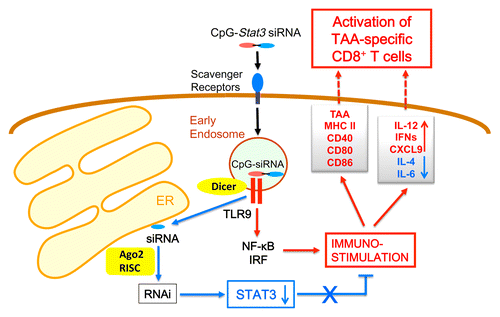Figures & data
Figure 1. A “Push&Release” strategy for increasing the immunogenicity of acute myeloid leukemia cells. CpG oligodeoxynucleotides (CpG-ODN)-coupled signal transducer and activator of transcription 3 (STAT3)-targeting small-interfering RNAs (CpG-Stat3 siRNAs) are internalized by scavenger receptors and bind to Toll-like receptor 9 (TLR9) within endosomes. Therein, siRNAs are cleaved off from the conjugate by dicer 1, ribonuclease type III (DICER1). TLR9 facilitates the release and transport of STAT3-targeting siRNAs to argonaute RISC catalytic component 2 (AGO2) in the endoplasmic reticulum (ER), thereby initiating RNA interference (RNAi) and limiting STAT3 activity. The inhibition of STAT3 augments the immunostimulatory effects of TLR9 signaling, shifting the balance toward the production of pro-inflammatory cytokines and chemokines. At the same time, blocking STAT3 and stimulating TLR9 enhances the presentation of leukemia-specific antigens. Altogether, these effects generate systemic leukemia-specific CD8+ T cell-mediated immune responses and result in disease regression.

